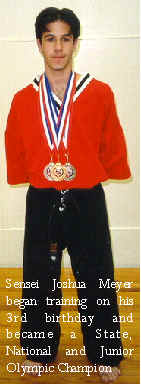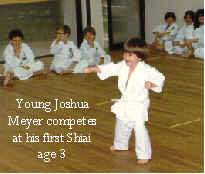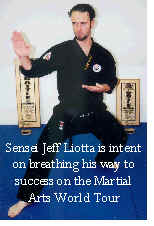October
Newsletter
Promotion from Karate Tigers to Junior Classes
 Every
Tuesday and Thursday, the Karate Tigers train with Sensei Smith and Sensei
Restrepo to have fun, play games, and most importantly, learn the basics of
karate. These four and five-year-old students look forward to their bi-weekly
sessions of punching and kicking the pads and learning how to do the more
difficult activities, like push-ups.
Every
Tuesday and Thursday, the Karate Tigers train with Sensei Smith and Sensei
Restrepo to have fun, play games, and most importantly, learn the basics of
karate. These four and five-year-old students look forward to their bi-weekly
sessions of punching and kicking the pads and learning how to do the more
difficult activities, like push-ups.
The Karate Tigers get blue stripes on their belts when they
do well in class so that, unlike the Junior students, they are not limited to
three stripes. They can earn as many blue stripes as their belts can hold. This
method keeps the less experienced children motivated, as well as the students
who have been in class longer, by providing a positive reinforcement process.
Eventually the opportunity arises to promote students from
the Karate Tigers class to the Junior program. This will normally be when the
student reaches six years of age, unless they are promoted sooner because the
Sensei considers that they are ready to work within the more disciplined
curriculum structure of the Junior program.
You may know some of our regular students that have been
promoted from the Karate Tigers program, namely Maxim Hew, Gianna Brigida and
Jonathan Barnes. Jonathan is currently a yellow belt, and Maxim and Gianna are
now brown belts. They have progressed steadily since their transition from the
Tigers program and have a depth of experience that reflects their years of
training.

This month, the University Karate Center will be promoting
Rikki Boldt into the Junior program. He has been attending the Tigers program
for over a year and was awarded one red stripe this summer, to begin his
transition and remind him of the great responsibility he holds as being a
student of the martial arts. “Rikki has been a good role model for the younger
Tigers during his time in the program, and I can see that his development will
continue with this promotion,” says Sensei Kendra Smith, his instructor.
The Geese
-Anonymous
 If
you ever have the opportunity to see geese flying along in V formation, you
might consider what science has discovered as to why they fly that way: As each
bird flaps its wings, it creates uplift for the bird immediately following. By
flying in V formation the whole flock adds at least 71% greater flying range
than if each bird flew on its own. People who share a common direction and sense
of community can get where they are going more quickly and easily because they
are traveling on the thrust of one another..
If
you ever have the opportunity to see geese flying along in V formation, you
might consider what science has discovered as to why they fly that way: As each
bird flaps its wings, it creates uplift for the bird immediately following. By
flying in V formation the whole flock adds at least 71% greater flying range
than if each bird flew on its own. People who share a common direction and sense
of community can get where they are going more quickly and easily because they
are traveling on the thrust of one another..
When a goose falls out of
formation, it suddenly feels the drag and resistance of trying to go it alone
and quickly gets back into formation to take advantage of the lifting power of
the bird in front. If we have as much sense as a goose, we will stay in
formation with those who are headed the same way we are.
When the Head Goose gets
tired, it rotates back in the wing and another goose flies point. It is sensible
to take turns doing demanding jobs with people or with geese flying south. Geese
honk from behind to encourage those up front to keep up their speed. What do we
say when we honk from behind?
Finally, and this is
important, when a goose gets sick or is wounded and falls out of formation, two
other geese fall out with that goose and follow it down to lend help and
protection. They stay with the fallen goose until it is able to fly, or until it
dies; only then do they launch out on their own, or with another formation to
catch up with their group.
If we have the sense of a
goose, we will stand by each other like that.
Annual PUMPKIN contest
This year’s Halloween pumpkin
carving contest will be held on Thursday October 30th from 4:00 to 7:00 pm. All
pumpkins must be real (not plastic/paper) and carved by the person entering
(please, no parents entering for their kids). There will be four divisions:
originally created pumpkins and pumpkins carved using stencils for both Children
and Adults (including teens). A maximum of two pumpkin entries is allowed, so
everyone may enter both divisions for their age. Last year’s winner was
Kaitlyn Reichenbach. This year’s winners will all receive a Karate School
T-Shirt!


Better Breathing Brings Peak Performance
Inhale and exhale, in and out. Breathing is one of the most
natural functions of our bodies. Or is it? In spite of its importance, many
people have developed shallow and uneven breathing habits. Effective breathing
can make a measurable difference in Martial Arts performance and in many other
endeavors we undertake. When you inhale, or breathe in, the air you take in goes
through a multi-step filtering process before reaching your lungs. Specialized
lung structures extract oxygen and leach it into your bloodstream, where it
travels to various oxygen-hungry tissues, such as the brain and the large
muscles. This cycle occurs tens of thousands of times each day, unnoticed, until
you really push yourself in Martial Arts class and discover how much work
breathing can be.
With additional exertion, the process picks up speed trying
to accommodate the body’s increased demand for oxygen and blood. The heart
pumps faster, attempting to meet the demands of muscles engaged in high activity
for oxygenated blood and the removal of waste carbon dioxide. Regular deep
breathing can allow the development of greater stamina, strength and mobility as
well as greater mental focus, all of which are hallmarks of excellence in
Martial Arts.
During practice, whether in class or at home, it is essential
to breathe correctly. The exhalation (breathing out) must be emphasized in order
to stimulate the parasympathetic nervous system to slow the heartbeat, lower the
blood pressure and lower the pulse rate. When focus is placed on the exhalation
and the abs are contracted with the breath, a feeling of centeredness is
developed which improves balance and coordination. Correct abdominal breathing
of this kind also serves to reduce stress and clear the lungs to make room for
more oxygen to be taken up on the subsequent inhalation (breathing in). Better
breathing while exercising will burn more calories and encourage the development
of a lean physique.

Many women learn the importance of breathing when they
prepare for childbirth. Breathing is utilized during labor to allow more control
during delivery, in much the same way that breathing is used in Martial Arts to
control both the mind and the body during practice and performance. During
Martial Arts sparring matches, for example, the adrenaline that enters the
bloodstream can make us strong or turn our knees to jelly. It is called the “fight
or flight” hormone and must be controlled by breathing and the subsequent
emotional balance. In real self-defense situations “adrenaline shock” can
totally incapacitate an otherwise competent individual if they allow the hormone
to take control. Again the emphasis is always on strong exhalation. The breath
is then allowed to flow back into the belly before being expelled again. If all
of the attention of the Martial Artist is on their breathing their emotions will
come into balance and their mind will be clear to focus on the opponent.
Just as women can learn to harness the power of the breath to
deal with the enormous internal natural forces brought to bear on them during
childbirth, so the Martial Artist can learn to breath for balance, emotional
strength and mental clarity during the pressures of a sparring match or a real
life self-defense situation. Deep connected abdominal breathing is also the
healthy way to breathe during our everyday activities. Correct breathing
encourages better balance and coordination. Even racing car drivers “breathe”
around corners and tennis players can be heard to exhale on every strike of the
ball. Abdominal breathing also encourages proper digestion and balances the
metabolism. The goal is to practice better breathing for peak performance
continuously.
Sensei Robert H. Mason © 2003
Back
 Every
Tuesday and Thursday, the Karate Tigers train with Sensei Smith and Sensei
Restrepo to have fun, play games, and most importantly, learn the basics of
karate. These four and five-year-old students look forward to their bi-weekly
sessions of punching and kicking the pads and learning how to do the more
difficult activities, like push-ups.
Every
Tuesday and Thursday, the Karate Tigers train with Sensei Smith and Sensei
Restrepo to have fun, play games, and most importantly, learn the basics of
karate. These four and five-year-old students look forward to their bi-weekly
sessions of punching and kicking the pads and learning how to do the more
difficult activities, like push-ups.
 If
you ever have the opportunity to see geese flying along in V formation, you
might consider what science has discovered as to why they fly that way: As each
bird flaps its wings, it creates uplift for the bird immediately following. By
flying in V formation the whole flock adds at least 71% greater flying range
than if each bird flew on its own. People who share a common direction and sense
of community can get where they are going more quickly and easily because they
are traveling on the thrust of one another..
If
you ever have the opportunity to see geese flying along in V formation, you
might consider what science has discovered as to why they fly that way: As each
bird flaps its wings, it creates uplift for the bird immediately following. By
flying in V formation the whole flock adds at least 71% greater flying range
than if each bird flew on its own. People who share a common direction and sense
of community can get where they are going more quickly and easily because they
are traveling on the thrust of one another..

